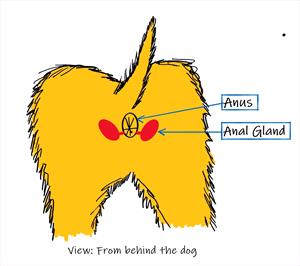What is that smell?! A foul fishy odor! UGH-It’s Anal Glands!
What are Anal Glands?
Anal Glands are fluid filled sacs embedded in the muscle tissue surrounding the anus. They are located at approximately 4 and 8 o’clock positions around the anus. These sacs fill with a foul-smelling fluid that is thought to be used in scent marking. Although we as humans cannot comprehend the importance of such foul functions, behaviorists believe that animals can gather much olfactory information.

How do they work?
Through normal defecation processes, anal sac material coats feces upon excretion. The pressure placed from well-formed stool allows the fluid to press through its tiny duct located at 2 o’clock. Problems occur in this process if stool is not well-formed. Anal sacs can become over filled or clogged after issues with diarrhea. Many animals begin to “scoot” or lick at the anal area in an effort to encourage expression. If anal sacs are blocked/clogged they become very uncomfortable and painful. Animals are hesitant to jump up, go up the stairs, tuck their tails, or not move much due to pain from anal sacs.
In some cases, anal sacs can abscess. Due to thickening of the fluid and being unable to empty over a period of time, the sac’s skin can burst out or inward causing a painful open and draining lesion. Seek professional veterinary care in this instance.
When to Express?
Every animal is different regarding their anal sacs. Some never have a problem or need manual expression throughout their lifetime. Some consistently need help to empty or face abscesses.
Remember: anal glands expressing are part of a NORMAL defecation process for both dogs and cats. However, anal glands should be “checked” by a professional if: they cause pain/discomfort, dogs are scooting/licking at area, a cherry red lump near rectum develops, recurring soft/unformed stools or diarrhea transpire, or your pet has a history of problematic anal glands.
Proper diet is important for many reasons but also for the development of well-formed stools leading to proper functioning anal glands. Keep it simple, keep it healthy, and nutritionally sound.
As always, if you have any concerns, seek out your referring DVM and veterinary staff! We are here to help!
Article written by: LaRhea
1 Image taken from veterinarypartner.com. Illustration by Shalini Radhakrishnan/VIN. No changes made.